Effectiveness of Precede-Proceed Model in Type 2 Diabetes Prevention
VerifiedAdded on 2022/01/01
|16
|3583
|84
Report
AI Summary
This report investigates the issue of type 2 diabetes among the Latina population in the USA, highlighting the increasing prevalence and the need for effective intervention strategies. It explores the Precede and Proceed model as a framework for assessing, designing, implementing, and evaluating health promotions. The analysis section examines the problem, including factors such as lack of health insurance and awareness, and proposes a SMART plan for intervention, including lifestyle changes and metformin intake. The report details the implementation of the SMART intervention through the Precede and Proceed model, discussing the Precede assessment (social, epidemiological, ecological, and administrative factors) and the Proceed assessment (implementation, process evaluation, impact evaluation, and outcome evaluation). The report concludes by summarizing the study's findings and offering recommendations for utilizing the Precede and Proceed model to mitigate type 2 diabetes risks among Latinas, including the positive outcomes observed from the intervention plan.
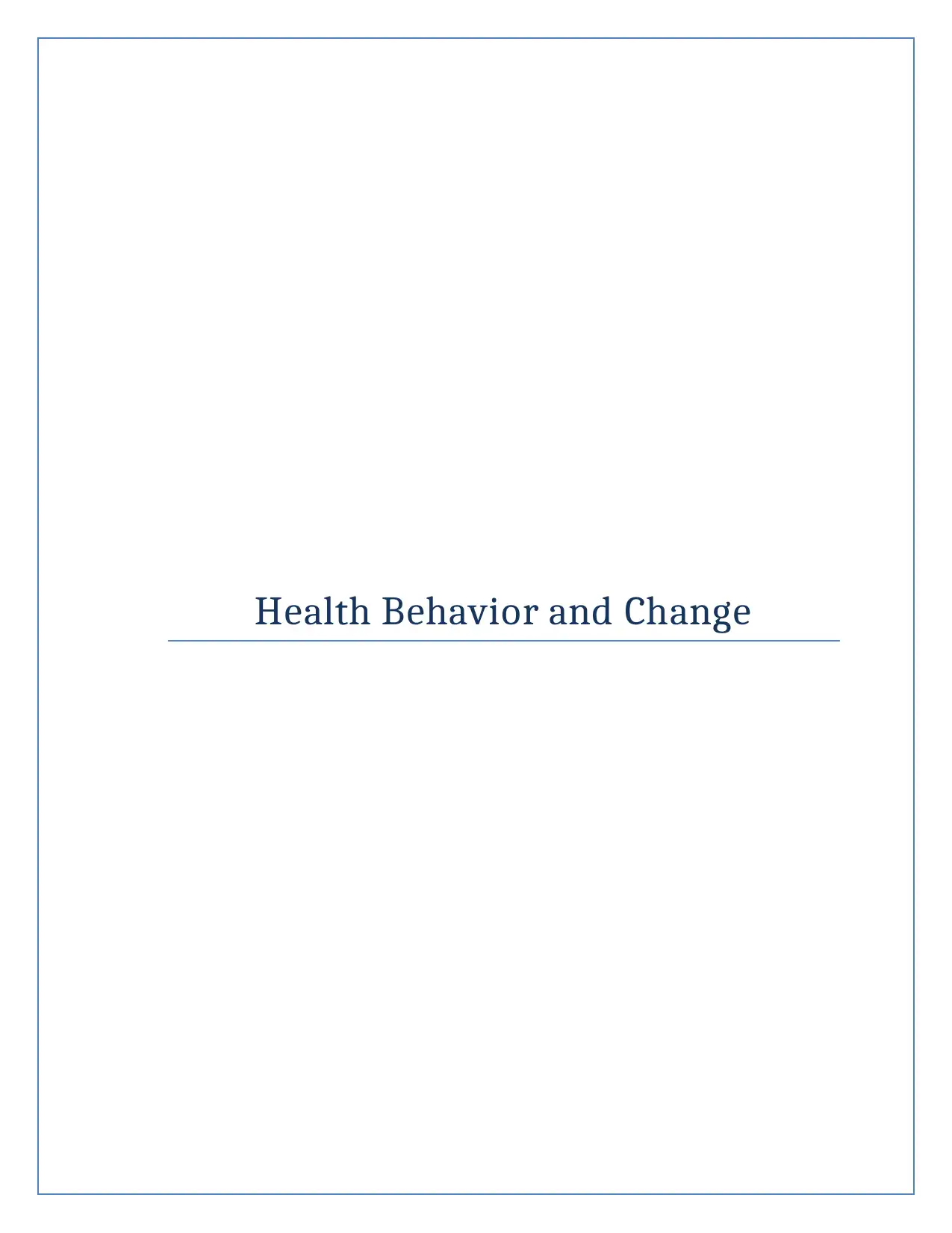
Health Behavior and Change
Paraphrase This Document
Need a fresh take? Get an instant paraphrase of this document with our AI Paraphraser
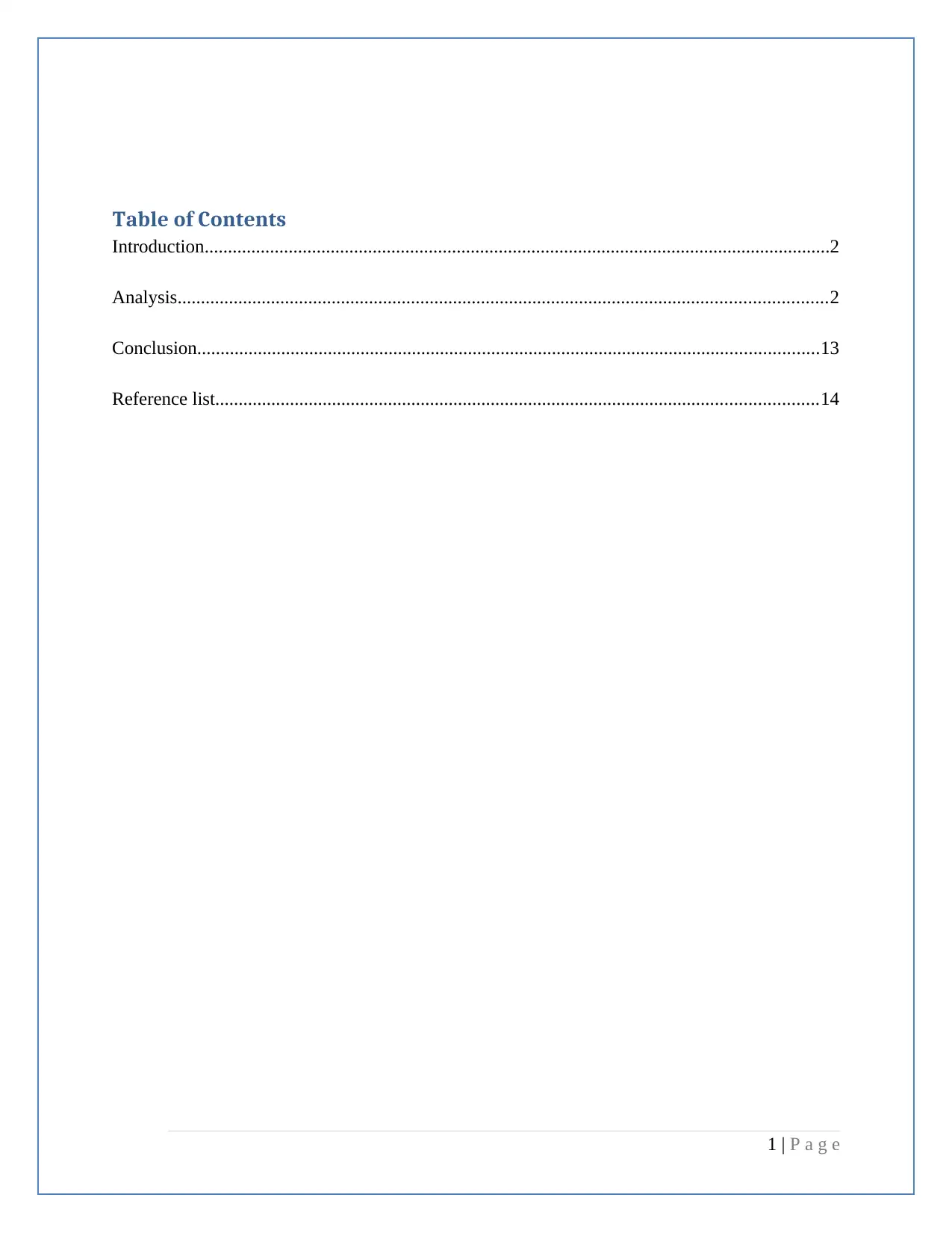
Table of Contents
Introduction......................................................................................................................................2
Analysis...........................................................................................................................................2
Conclusion.....................................................................................................................................13
Reference list.................................................................................................................................14
1 | P a g e
Introduction......................................................................................................................................2
Analysis...........................................................................................................................................2
Conclusion.....................................................................................................................................13
Reference list.................................................................................................................................14
1 | P a g e
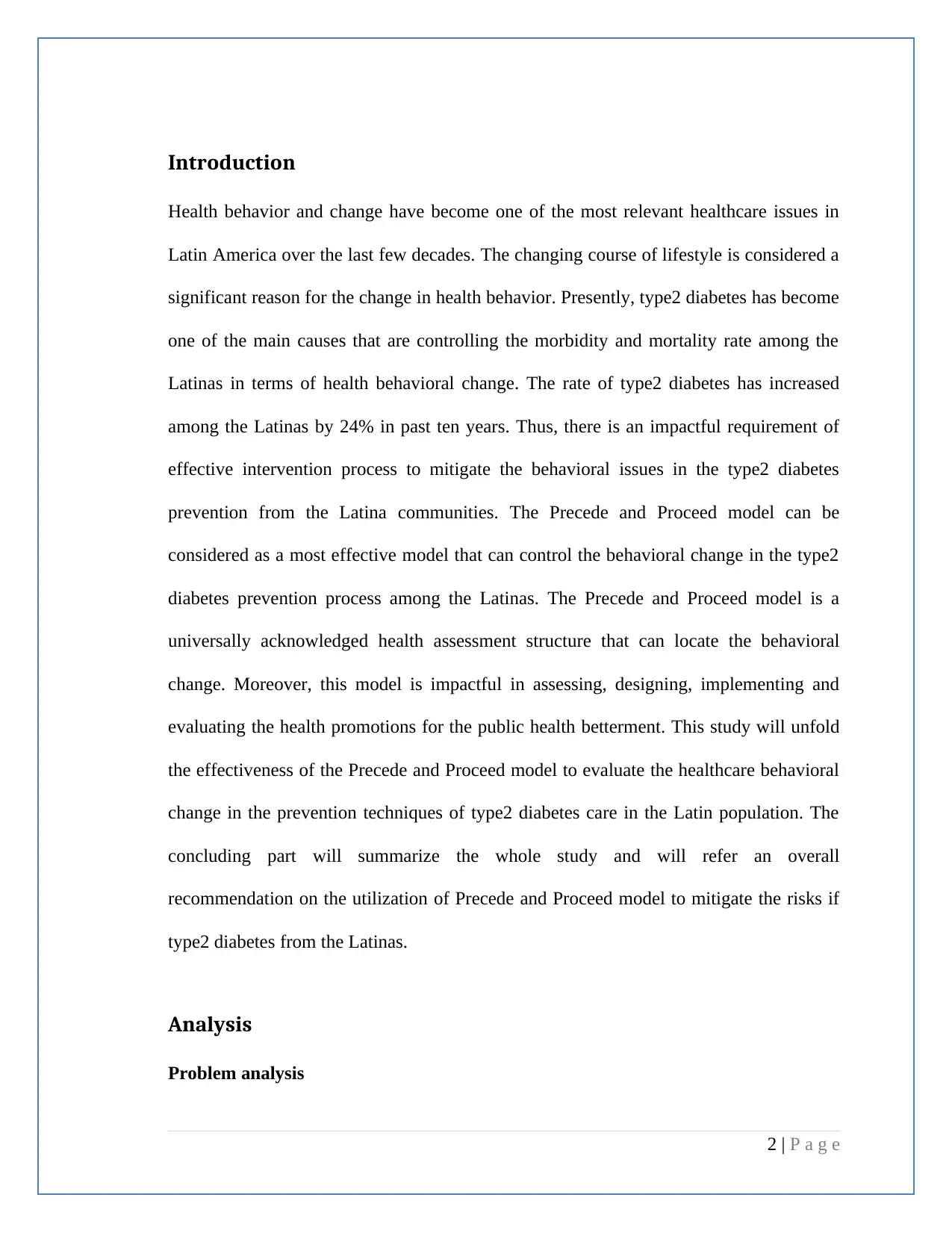
Introduction
Health behavior and change have become one of the most relevant healthcare issues in
Latin America over the last few decades. The changing course of lifestyle is considered a
significant reason for the change in health behavior. Presently, type2 diabetes has become
one of the main causes that are controlling the morbidity and mortality rate among the
Latinas in terms of health behavioral change. The rate of type2 diabetes has increased
among the Latinas by 24% in past ten years. Thus, there is an impactful requirement of
effective intervention process to mitigate the behavioral issues in the type2 diabetes
prevention from the Latina communities. The Precede and Proceed model can be
considered as a most effective model that can control the behavioral change in the type2
diabetes prevention process among the Latinas. The Precede and Proceed model is a
universally acknowledged health assessment structure that can locate the behavioral
change. Moreover, this model is impactful in assessing, designing, implementing and
evaluating the health promotions for the public health betterment. This study will unfold
the effectiveness of the Precede and Proceed model to evaluate the healthcare behavioral
change in the prevention techniques of type2 diabetes care in the Latin population. The
concluding part will summarize the whole study and will refer an overall
recommendation on the utilization of Precede and Proceed model to mitigate the risks if
type2 diabetes from the Latinas.
Analysis
Problem analysis
2 | P a g e
Health behavior and change have become one of the most relevant healthcare issues in
Latin America over the last few decades. The changing course of lifestyle is considered a
significant reason for the change in health behavior. Presently, type2 diabetes has become
one of the main causes that are controlling the morbidity and mortality rate among the
Latinas in terms of health behavioral change. The rate of type2 diabetes has increased
among the Latinas by 24% in past ten years. Thus, there is an impactful requirement of
effective intervention process to mitigate the behavioral issues in the type2 diabetes
prevention from the Latina communities. The Precede and Proceed model can be
considered as a most effective model that can control the behavioral change in the type2
diabetes prevention process among the Latinas. The Precede and Proceed model is a
universally acknowledged health assessment structure that can locate the behavioral
change. Moreover, this model is impactful in assessing, designing, implementing and
evaluating the health promotions for the public health betterment. This study will unfold
the effectiveness of the Precede and Proceed model to evaluate the healthcare behavioral
change in the prevention techniques of type2 diabetes care in the Latin population. The
concluding part will summarize the whole study and will refer an overall
recommendation on the utilization of Precede and Proceed model to mitigate the risks if
type2 diabetes from the Latinas.
Analysis
Problem analysis
2 | P a g e
You're viewing a preview
Unlock full access by subscribing today!
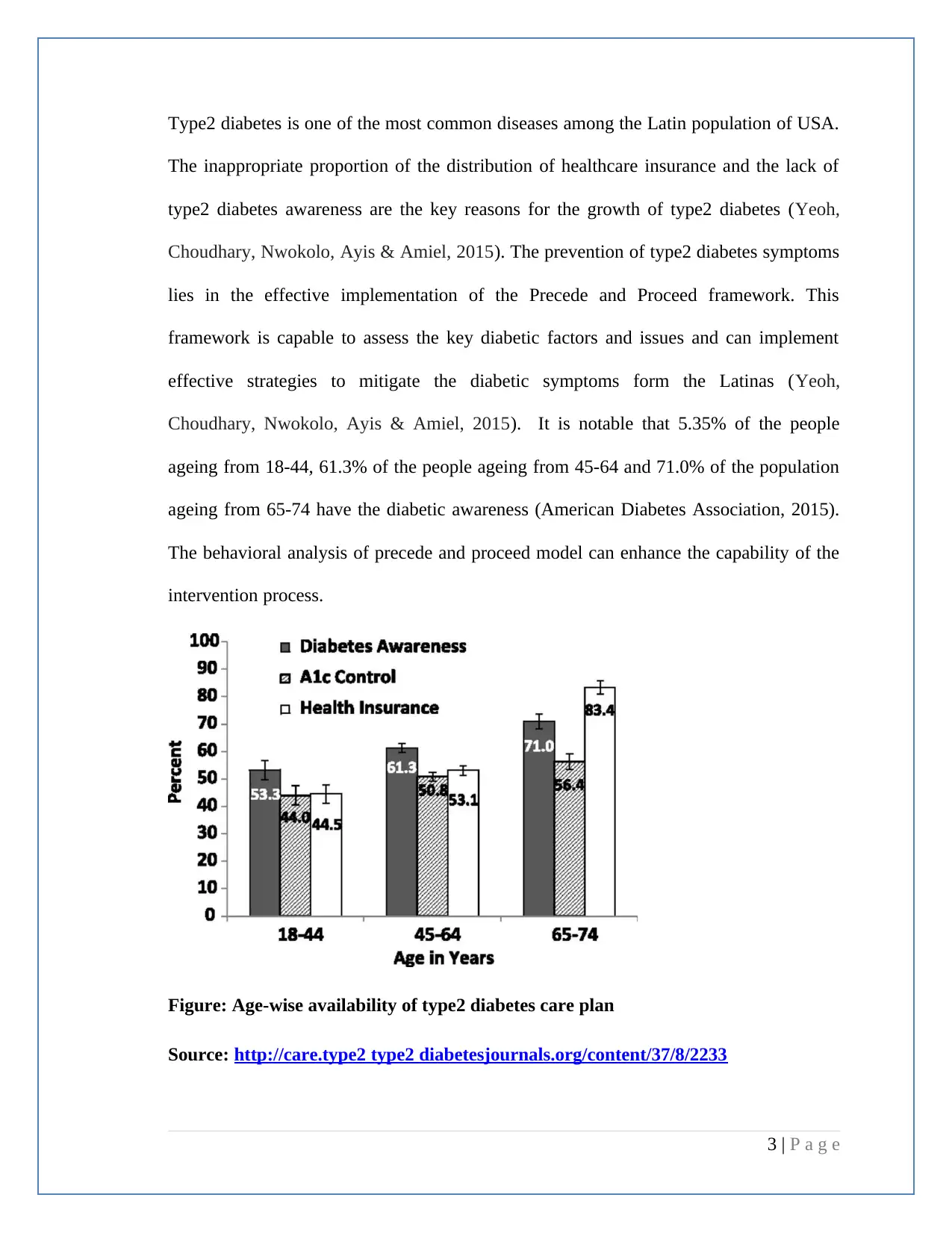
Type2 diabetes is one of the most common diseases among the Latin population of USA.
The inappropriate proportion of the distribution of healthcare insurance and the lack of
type2 diabetes awareness are the key reasons for the growth of type2 diabetes (Yeoh,
Choudhary, Nwokolo, Ayis & Amiel, 2015). The prevention of type2 diabetes symptoms
lies in the effective implementation of the Precede and Proceed framework. This
framework is capable to assess the key diabetic factors and issues and can implement
effective strategies to mitigate the diabetic symptoms form the Latinas (Yeoh,
Choudhary, Nwokolo, Ayis & Amiel, 2015). It is notable that 5.35% of the people
ageing from 18-44, 61.3% of the people ageing from 45-64 and 71.0% of the population
ageing from 65-74 have the diabetic awareness (American Diabetes Association, 2015).
The behavioral analysis of precede and proceed model can enhance the capability of the
intervention process.
Figure: Age-wise availability of type2 diabetes care plan
Source: http://care.type2 type2 diabetesjournals.org/content/37/8/2233
3 | P a g e
The inappropriate proportion of the distribution of healthcare insurance and the lack of
type2 diabetes awareness are the key reasons for the growth of type2 diabetes (Yeoh,
Choudhary, Nwokolo, Ayis & Amiel, 2015). The prevention of type2 diabetes symptoms
lies in the effective implementation of the Precede and Proceed framework. This
framework is capable to assess the key diabetic factors and issues and can implement
effective strategies to mitigate the diabetic symptoms form the Latinas (Yeoh,
Choudhary, Nwokolo, Ayis & Amiel, 2015). It is notable that 5.35% of the people
ageing from 18-44, 61.3% of the people ageing from 45-64 and 71.0% of the population
ageing from 65-74 have the diabetic awareness (American Diabetes Association, 2015).
The behavioral analysis of precede and proceed model can enhance the capability of the
intervention process.
Figure: Age-wise availability of type2 diabetes care plan
Source: http://care.type2 type2 diabetesjournals.org/content/37/8/2233
3 | P a g e
Paraphrase This Document
Need a fresh take? Get an instant paraphrase of this document with our AI Paraphraser
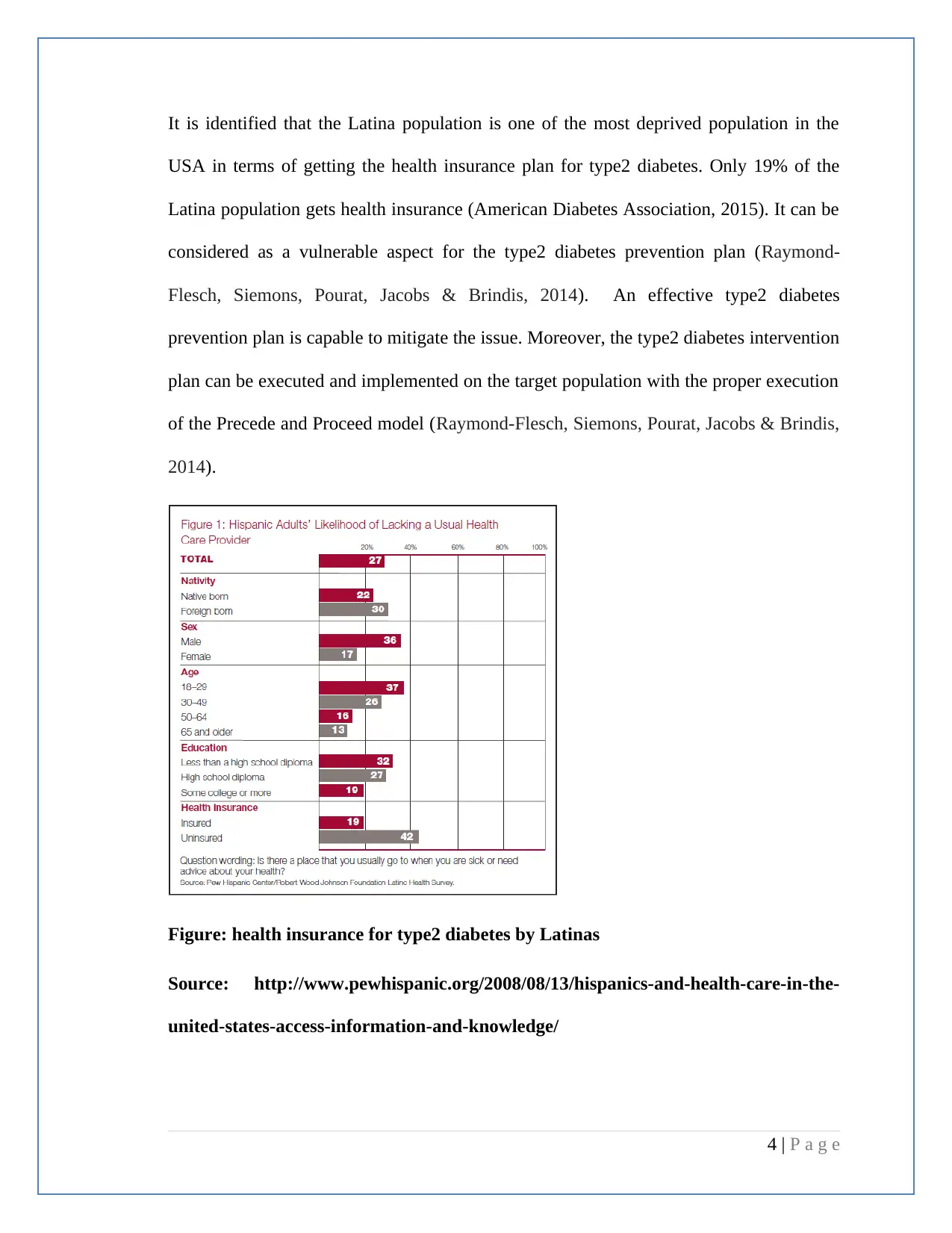
It is identified that the Latina population is one of the most deprived population in the
USA in terms of getting the health insurance plan for type2 diabetes. Only 19% of the
Latina population gets health insurance (American Diabetes Association, 2015). It can be
considered as a vulnerable aspect for the type2 diabetes prevention plan (Raymond-
Flesch, Siemons, Pourat, Jacobs & Brindis, 2014). An effective type2 diabetes
prevention plan is capable to mitigate the issue. Moreover, the type2 diabetes intervention
plan can be executed and implemented on the target population with the proper execution
of the Precede and Proceed model (Raymond-Flesch, Siemons, Pourat, Jacobs & Brindis,
2014).
Figure: health insurance for type2 diabetes by Latinas
Source: http://www.pewhispanic.org/2008/08/13/hispanics-and-health-care-in-the-
united-states-access-information-and-knowledge/
4 | P a g e
USA in terms of getting the health insurance plan for type2 diabetes. Only 19% of the
Latina population gets health insurance (American Diabetes Association, 2015). It can be
considered as a vulnerable aspect for the type2 diabetes prevention plan (Raymond-
Flesch, Siemons, Pourat, Jacobs & Brindis, 2014). An effective type2 diabetes
prevention plan is capable to mitigate the issue. Moreover, the type2 diabetes intervention
plan can be executed and implemented on the target population with the proper execution
of the Precede and Proceed model (Raymond-Flesch, Siemons, Pourat, Jacobs & Brindis,
2014).
Figure: health insurance for type2 diabetes by Latinas
Source: http://www.pewhispanic.org/2008/08/13/hispanics-and-health-care-in-the-
united-states-access-information-and-knowledge/
4 | P a g e
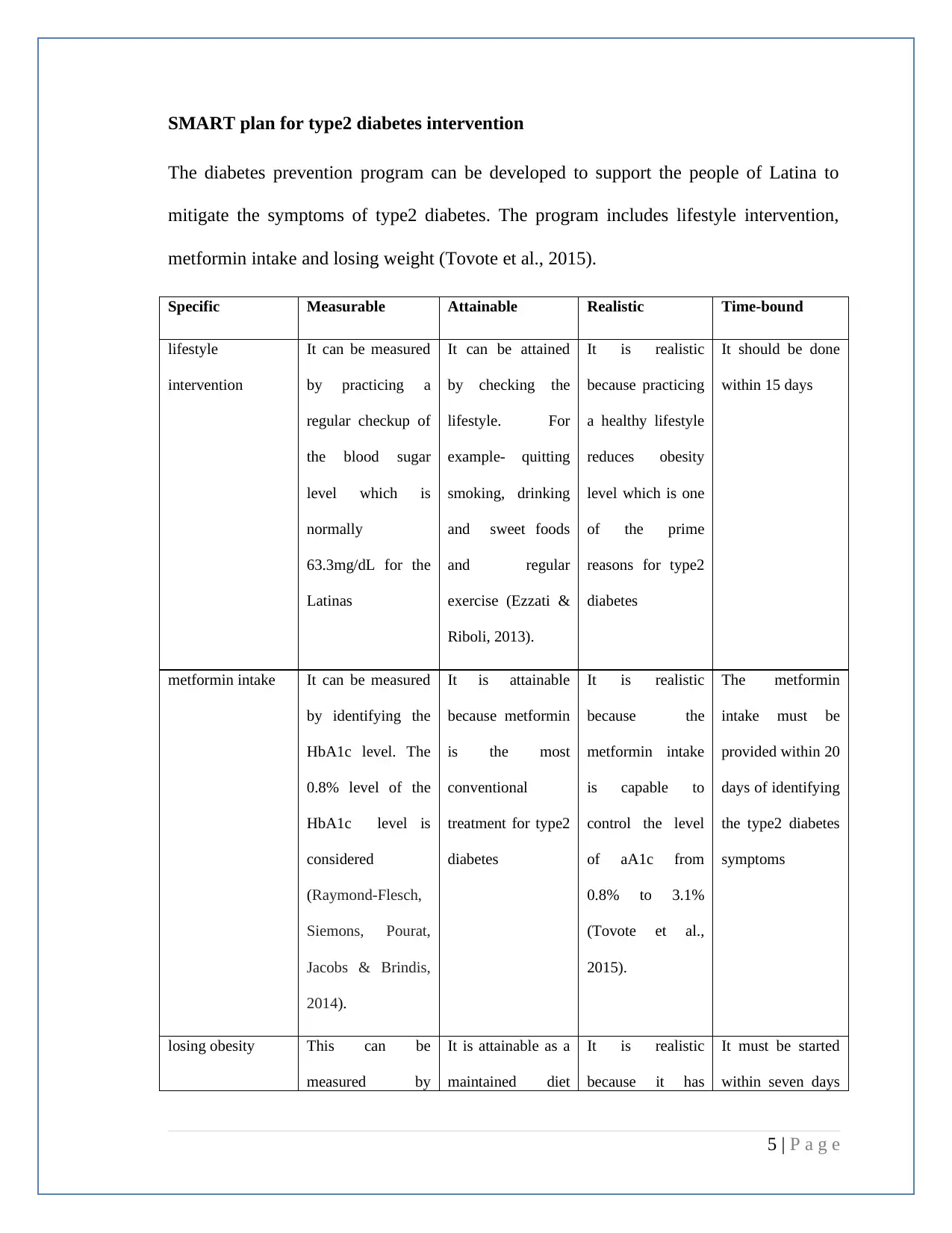
SMART plan for type2 diabetes intervention
The diabetes prevention program can be developed to support the people of Latina to
mitigate the symptoms of type2 diabetes. The program includes lifestyle intervention,
metformin intake and losing weight (Tovote et al., 2015).
Specific Measurable Attainable Realistic Time-bound
lifestyle
intervention
It can be measured
by practicing a
regular checkup of
the blood sugar
level which is
normally
63.3mg/dL for the
Latinas
It can be attained
by checking the
lifestyle. For
example- quitting
smoking, drinking
and sweet foods
and regular
exercise (Ezzati &
Riboli, 2013).
It is realistic
because practicing
a healthy lifestyle
reduces obesity
level which is one
of the prime
reasons for type2
diabetes
It should be done
within 15 days
metformin intake It can be measured
by identifying the
HbA1c level. The
0.8% level of the
HbA1c level is
considered
(Raymond-Flesch,
Siemons, Pourat,
Jacobs & Brindis,
2014).
It is attainable
because metformin
is the most
conventional
treatment for type2
diabetes
It is realistic
because the
metformin intake
is capable to
control the level
of aA1c from
0.8% to 3.1%
(Tovote et al.,
2015).
The metformin
intake must be
provided within 20
days of identifying
the type2 diabetes
symptoms
losing obesity This can be
measured by
It is attainable as a
maintained diet
It is realistic
because it has
It must be started
within seven days
5 | P a g e
The diabetes prevention program can be developed to support the people of Latina to
mitigate the symptoms of type2 diabetes. The program includes lifestyle intervention,
metformin intake and losing weight (Tovote et al., 2015).
Specific Measurable Attainable Realistic Time-bound
lifestyle
intervention
It can be measured
by practicing a
regular checkup of
the blood sugar
level which is
normally
63.3mg/dL for the
Latinas
It can be attained
by checking the
lifestyle. For
example- quitting
smoking, drinking
and sweet foods
and regular
exercise (Ezzati &
Riboli, 2013).
It is realistic
because practicing
a healthy lifestyle
reduces obesity
level which is one
of the prime
reasons for type2
diabetes
It should be done
within 15 days
metformin intake It can be measured
by identifying the
HbA1c level. The
0.8% level of the
HbA1c level is
considered
(Raymond-Flesch,
Siemons, Pourat,
Jacobs & Brindis,
2014).
It is attainable
because metformin
is the most
conventional
treatment for type2
diabetes
It is realistic
because the
metformin intake
is capable to
control the level
of aA1c from
0.8% to 3.1%
(Tovote et al.,
2015).
The metformin
intake must be
provided within 20
days of identifying
the type2 diabetes
symptoms
losing obesity This can be
measured by
It is attainable as a
maintained diet
It is realistic
because it has
It must be started
within seven days
5 | P a g e
You're viewing a preview
Unlock full access by subscribing today!
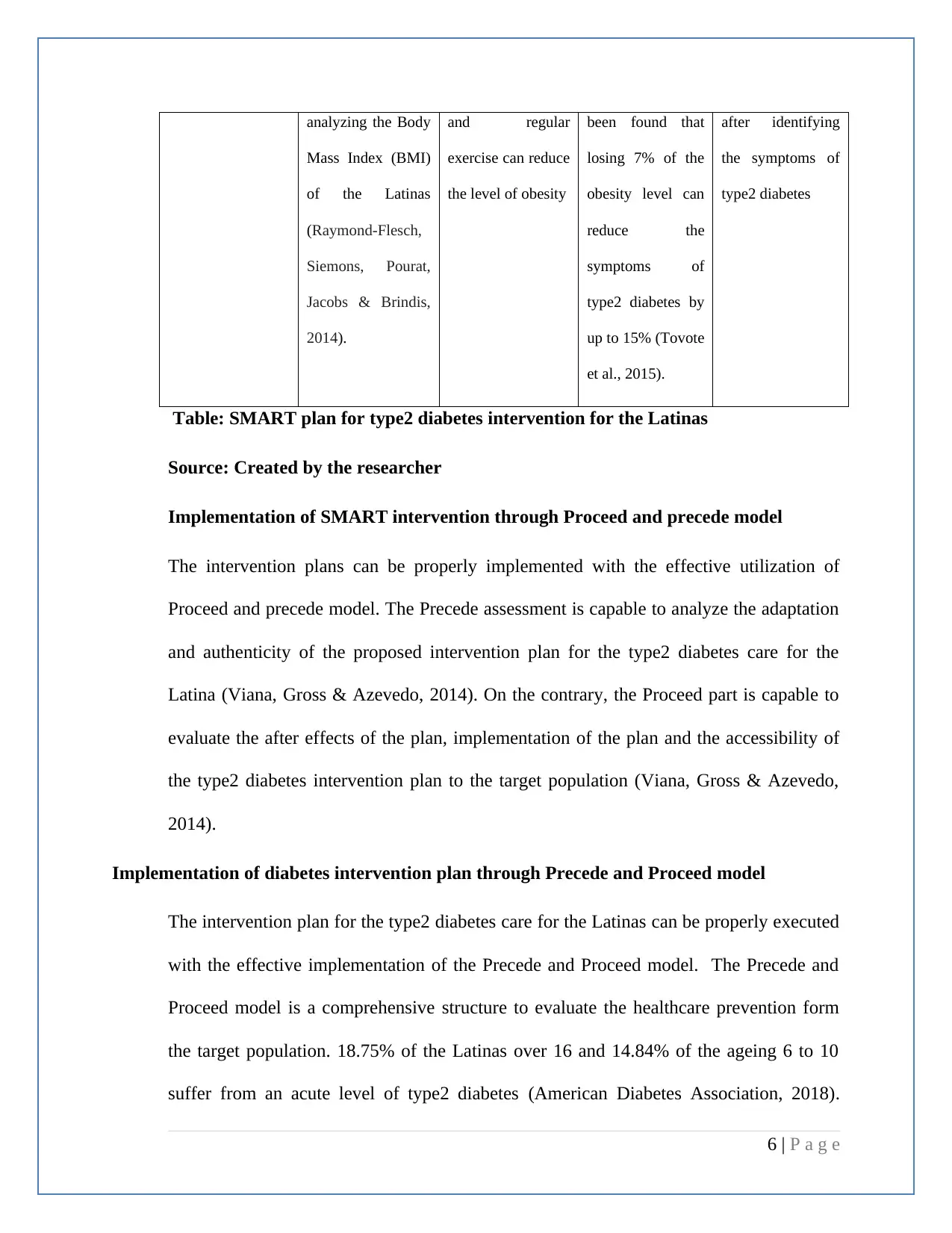
analyzing the Body
Mass Index (BMI)
of the Latinas
(Raymond-Flesch,
Siemons, Pourat,
Jacobs & Brindis,
2014).
and regular
exercise can reduce
the level of obesity
been found that
losing 7% of the
obesity level can
reduce the
symptoms of
type2 diabetes by
up to 15% (Tovote
et al., 2015).
after identifying
the symptoms of
type2 diabetes
Table: SMART plan for type2 diabetes intervention for the Latinas
Source: Created by the researcher
Implementation of SMART intervention through Proceed and precede model
The intervention plans can be properly implemented with the effective utilization of
Proceed and precede model. The Precede assessment is capable to analyze the adaptation
and authenticity of the proposed intervention plan for the type2 diabetes care for the
Latina (Viana, Gross & Azevedo, 2014). On the contrary, the Proceed part is capable to
evaluate the after effects of the plan, implementation of the plan and the accessibility of
the type2 diabetes intervention plan to the target population (Viana, Gross & Azevedo,
2014).
Implementation of diabetes intervention plan through Precede and Proceed model
The intervention plan for the type2 diabetes care for the Latinas can be properly executed
with the effective implementation of the Precede and Proceed model. The Precede and
Proceed model is a comprehensive structure to evaluate the healthcare prevention form
the target population. 18.75% of the Latinas over 16 and 14.84% of the ageing 6 to 10
suffer from an acute level of type2 diabetes (American Diabetes Association, 2018).
6 | P a g e
Mass Index (BMI)
of the Latinas
(Raymond-Flesch,
Siemons, Pourat,
Jacobs & Brindis,
2014).
and regular
exercise can reduce
the level of obesity
been found that
losing 7% of the
obesity level can
reduce the
symptoms of
type2 diabetes by
up to 15% (Tovote
et al., 2015).
after identifying
the symptoms of
type2 diabetes
Table: SMART plan for type2 diabetes intervention for the Latinas
Source: Created by the researcher
Implementation of SMART intervention through Proceed and precede model
The intervention plans can be properly implemented with the effective utilization of
Proceed and precede model. The Precede assessment is capable to analyze the adaptation
and authenticity of the proposed intervention plan for the type2 diabetes care for the
Latina (Viana, Gross & Azevedo, 2014). On the contrary, the Proceed part is capable to
evaluate the after effects of the plan, implementation of the plan and the accessibility of
the type2 diabetes intervention plan to the target population (Viana, Gross & Azevedo,
2014).
Implementation of diabetes intervention plan through Precede and Proceed model
The intervention plan for the type2 diabetes care for the Latinas can be properly executed
with the effective implementation of the Precede and Proceed model. The Precede and
Proceed model is a comprehensive structure to evaluate the healthcare prevention form
the target population. 18.75% of the Latinas over 16 and 14.84% of the ageing 6 to 10
suffer from an acute level of type2 diabetes (American Diabetes Association, 2018).
6 | P a g e
Paraphrase This Document
Need a fresh take? Get an instant paraphrase of this document with our AI Paraphraser
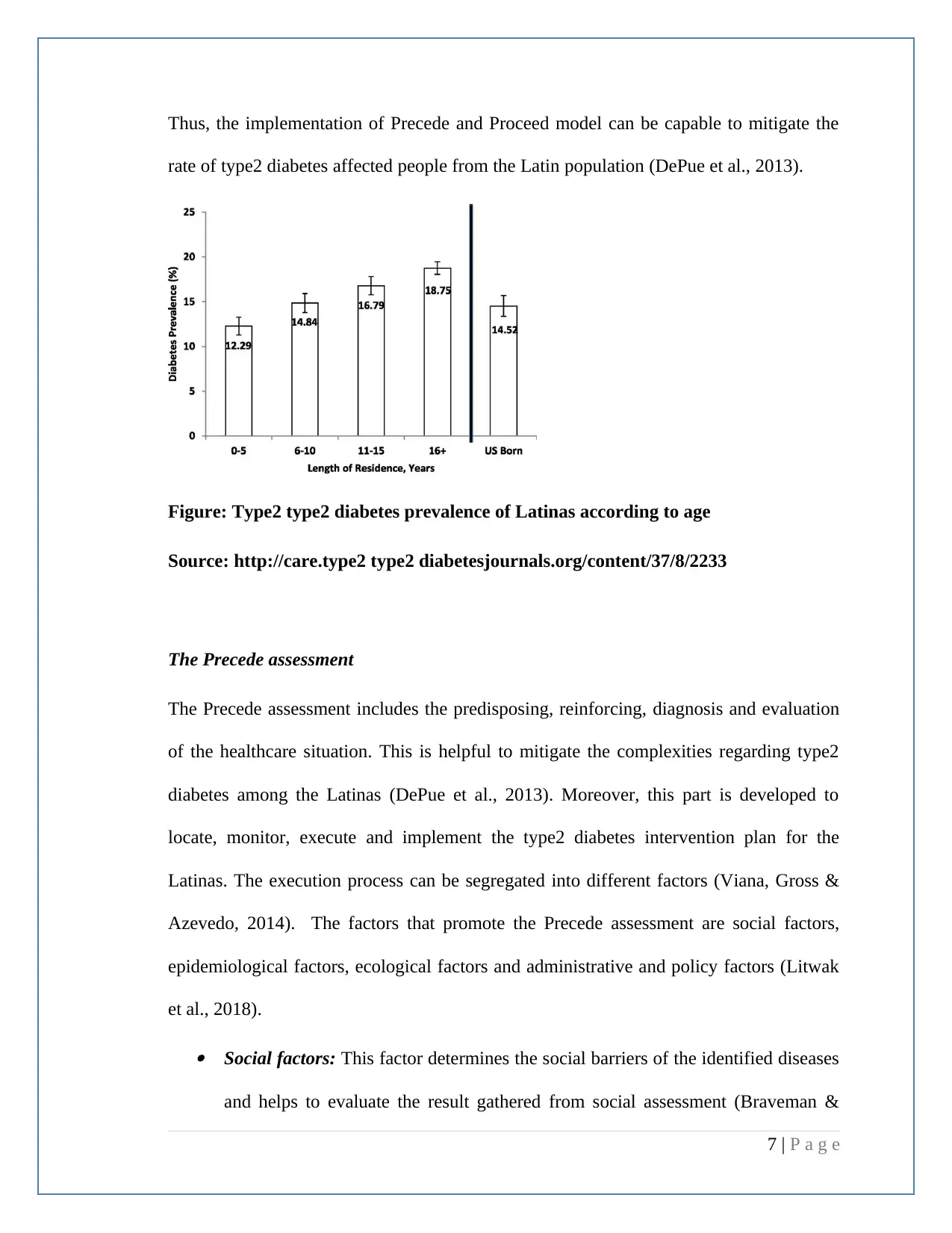
Thus, the implementation of Precede and Proceed model can be capable to mitigate the
rate of type2 diabetes affected people from the Latin population (DePue et al., 2013).
Figure: Type2 type2 diabetes prevalence of Latinas according to age
Source: http://care.type2 type2 diabetesjournals.org/content/37/8/2233
The Precede assessment
The Precede assessment includes the predisposing, reinforcing, diagnosis and evaluation
of the healthcare situation. This is helpful to mitigate the complexities regarding type2
diabetes among the Latinas (DePue et al., 2013). Moreover, this part is developed to
locate, monitor, execute and implement the type2 diabetes intervention plan for the
Latinas. The execution process can be segregated into different factors (Viana, Gross &
Azevedo, 2014). The factors that promote the Precede assessment are social factors,
epidemiological factors, ecological factors and administrative and policy factors (Litwak
et al., 2018). Social factors: This factor determines the social barriers of the identified diseases
and helps to evaluate the result gathered from social assessment (Braveman &
7 | P a g e
rate of type2 diabetes affected people from the Latin population (DePue et al., 2013).
Figure: Type2 type2 diabetes prevalence of Latinas according to age
Source: http://care.type2 type2 diabetesjournals.org/content/37/8/2233
The Precede assessment
The Precede assessment includes the predisposing, reinforcing, diagnosis and evaluation
of the healthcare situation. This is helpful to mitigate the complexities regarding type2
diabetes among the Latinas (DePue et al., 2013). Moreover, this part is developed to
locate, monitor, execute and implement the type2 diabetes intervention plan for the
Latinas. The execution process can be segregated into different factors (Viana, Gross &
Azevedo, 2014). The factors that promote the Precede assessment are social factors,
epidemiological factors, ecological factors and administrative and policy factors (Litwak
et al., 2018). Social factors: This factor determines the social barriers of the identified diseases
and helps to evaluate the result gathered from social assessment (Braveman &
7 | P a g e
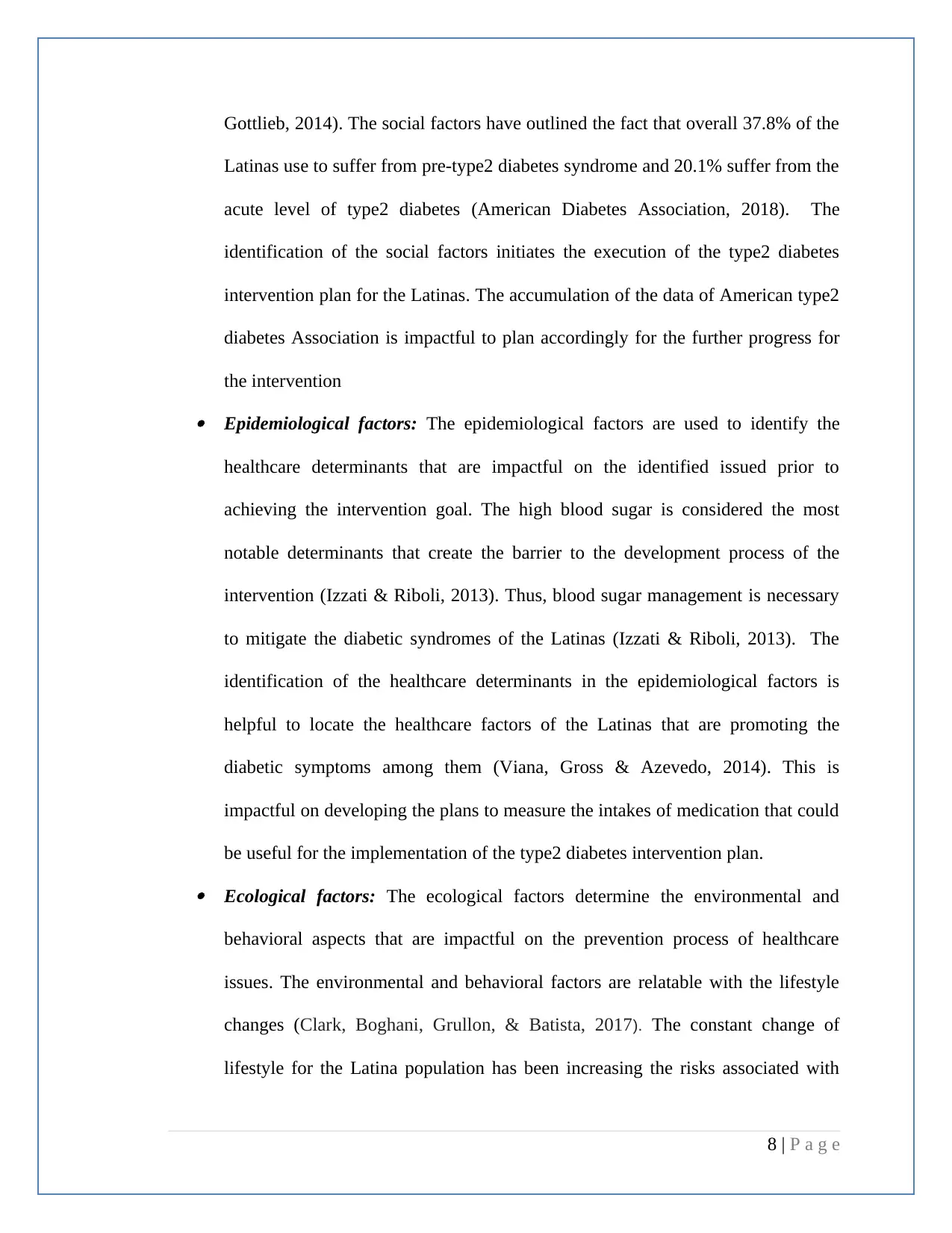
Gottlieb, 2014). The social factors have outlined the fact that overall 37.8% of the
Latinas use to suffer from pre-type2 diabetes syndrome and 20.1% suffer from the
acute level of type2 diabetes (American Diabetes Association, 2018). The
identification of the social factors initiates the execution of the type2 diabetes
intervention plan for the Latinas. The accumulation of the data of American type2
diabetes Association is impactful to plan accordingly for the further progress for
the intervention
Epidemiological factors: The epidemiological factors are used to identify the
healthcare determinants that are impactful on the identified issued prior to
achieving the intervention goal. The high blood sugar is considered the most
notable determinants that create the barrier to the development process of the
intervention (Izzati & Riboli, 2013). Thus, blood sugar management is necessary
to mitigate the diabetic syndromes of the Latinas (Izzati & Riboli, 2013). The
identification of the healthcare determinants in the epidemiological factors is
helpful to locate the healthcare factors of the Latinas that are promoting the
diabetic symptoms among them (Viana, Gross & Azevedo, 2014). This is
impactful on developing the plans to measure the intakes of medication that could
be useful for the implementation of the type2 diabetes intervention plan.
Ecological factors: The ecological factors determine the environmental and
behavioral aspects that are impactful on the prevention process of healthcare
issues. The environmental and behavioral factors are relatable with the lifestyle
changes (Clark, Boghani, Grullon, & Batista, 2017). The constant change of
lifestyle for the Latina population has been increasing the risks associated with
8 | P a g e
Latinas use to suffer from pre-type2 diabetes syndrome and 20.1% suffer from the
acute level of type2 diabetes (American Diabetes Association, 2018). The
identification of the social factors initiates the execution of the type2 diabetes
intervention plan for the Latinas. The accumulation of the data of American type2
diabetes Association is impactful to plan accordingly for the further progress for
the intervention
Epidemiological factors: The epidemiological factors are used to identify the
healthcare determinants that are impactful on the identified issued prior to
achieving the intervention goal. The high blood sugar is considered the most
notable determinants that create the barrier to the development process of the
intervention (Izzati & Riboli, 2013). Thus, blood sugar management is necessary
to mitigate the diabetic syndromes of the Latinas (Izzati & Riboli, 2013). The
identification of the healthcare determinants in the epidemiological factors is
helpful to locate the healthcare factors of the Latinas that are promoting the
diabetic symptoms among them (Viana, Gross & Azevedo, 2014). This is
impactful on developing the plans to measure the intakes of medication that could
be useful for the implementation of the type2 diabetes intervention plan.
Ecological factors: The ecological factors determine the environmental and
behavioral aspects that are impactful on the prevention process of healthcare
issues. The environmental and behavioral factors are relatable with the lifestyle
changes (Clark, Boghani, Grullon, & Batista, 2017). The constant change of
lifestyle for the Latina population has been increasing the risks associated with
8 | P a g e
You're viewing a preview
Unlock full access by subscribing today!
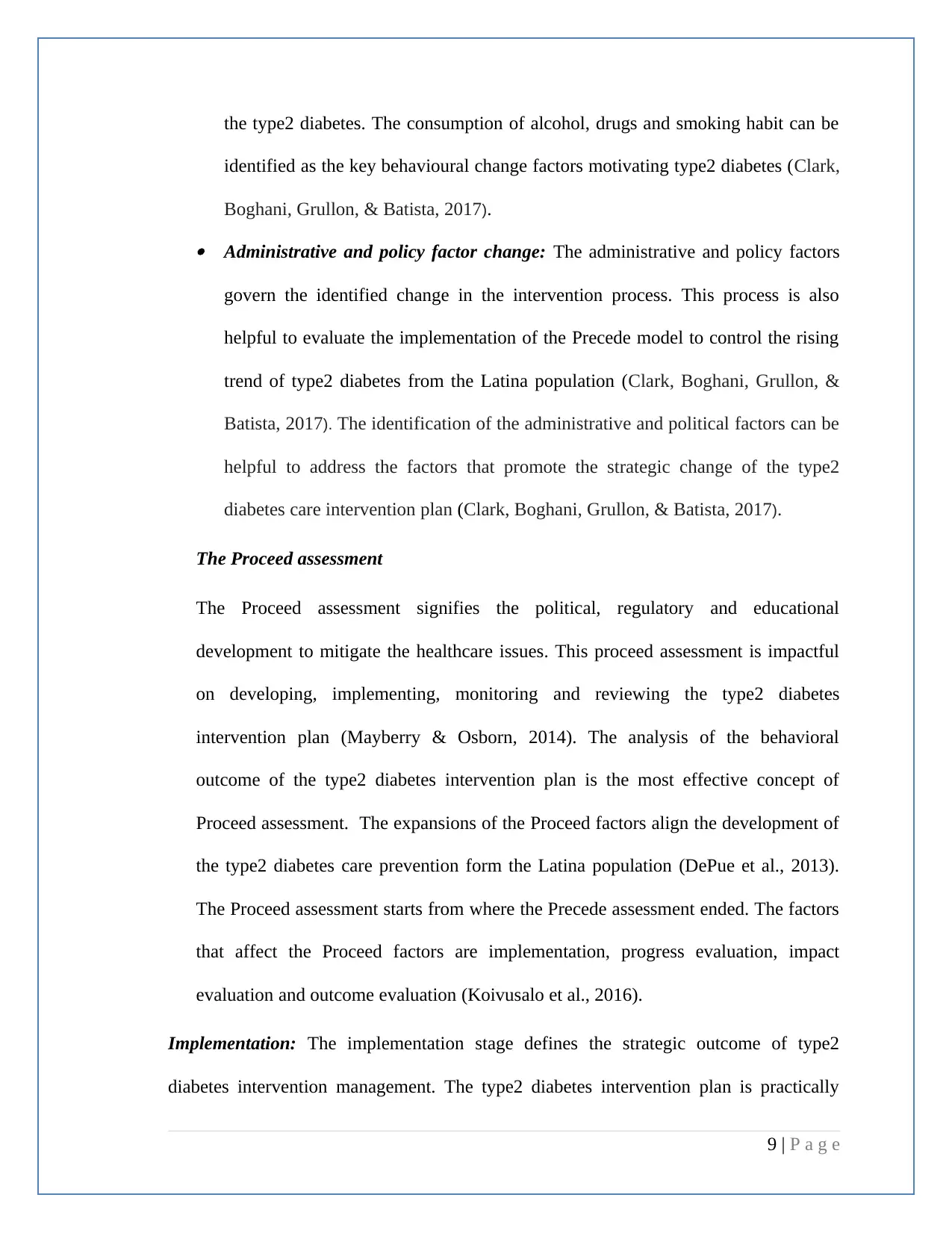
the type2 diabetes. The consumption of alcohol, drugs and smoking habit can be
identified as the key behavioural change factors motivating type2 diabetes (Clark,
Boghani, Grullon, & Batista, 2017).
Administrative and policy factor change: The administrative and policy factors
govern the identified change in the intervention process. This process is also
helpful to evaluate the implementation of the Precede model to control the rising
trend of type2 diabetes from the Latina population (Clark, Boghani, Grullon, &
Batista, 2017). The identification of the administrative and political factors can be
helpful to address the factors that promote the strategic change of the type2
diabetes care intervention plan (Clark, Boghani, Grullon, & Batista, 2017).
The Proceed assessment
The Proceed assessment signifies the political, regulatory and educational
development to mitigate the healthcare issues. This proceed assessment is impactful
on developing, implementing, monitoring and reviewing the type2 diabetes
intervention plan (Mayberry & Osborn, 2014). The analysis of the behavioral
outcome of the type2 diabetes intervention plan is the most effective concept of
Proceed assessment. The expansions of the Proceed factors align the development of
the type2 diabetes care prevention form the Latina population (DePue et al., 2013).
The Proceed assessment starts from where the Precede assessment ended. The factors
that affect the Proceed factors are implementation, progress evaluation, impact
evaluation and outcome evaluation (Koivusalo et al., 2016).
Implementation: The implementation stage defines the strategic outcome of type2
diabetes intervention management. The type2 diabetes intervention plan is practically
9 | P a g e
identified as the key behavioural change factors motivating type2 diabetes (Clark,
Boghani, Grullon, & Batista, 2017).
Administrative and policy factor change: The administrative and policy factors
govern the identified change in the intervention process. This process is also
helpful to evaluate the implementation of the Precede model to control the rising
trend of type2 diabetes from the Latina population (Clark, Boghani, Grullon, &
Batista, 2017). The identification of the administrative and political factors can be
helpful to address the factors that promote the strategic change of the type2
diabetes care intervention plan (Clark, Boghani, Grullon, & Batista, 2017).
The Proceed assessment
The Proceed assessment signifies the political, regulatory and educational
development to mitigate the healthcare issues. This proceed assessment is impactful
on developing, implementing, monitoring and reviewing the type2 diabetes
intervention plan (Mayberry & Osborn, 2014). The analysis of the behavioral
outcome of the type2 diabetes intervention plan is the most effective concept of
Proceed assessment. The expansions of the Proceed factors align the development of
the type2 diabetes care prevention form the Latina population (DePue et al., 2013).
The Proceed assessment starts from where the Precede assessment ended. The factors
that affect the Proceed factors are implementation, progress evaluation, impact
evaluation and outcome evaluation (Koivusalo et al., 2016).
Implementation: The implementation stage defines the strategic outcome of type2
diabetes intervention management. The type2 diabetes intervention plan is practically
9 | P a g e
Paraphrase This Document
Need a fresh take? Get an instant paraphrase of this document with our AI Paraphraser
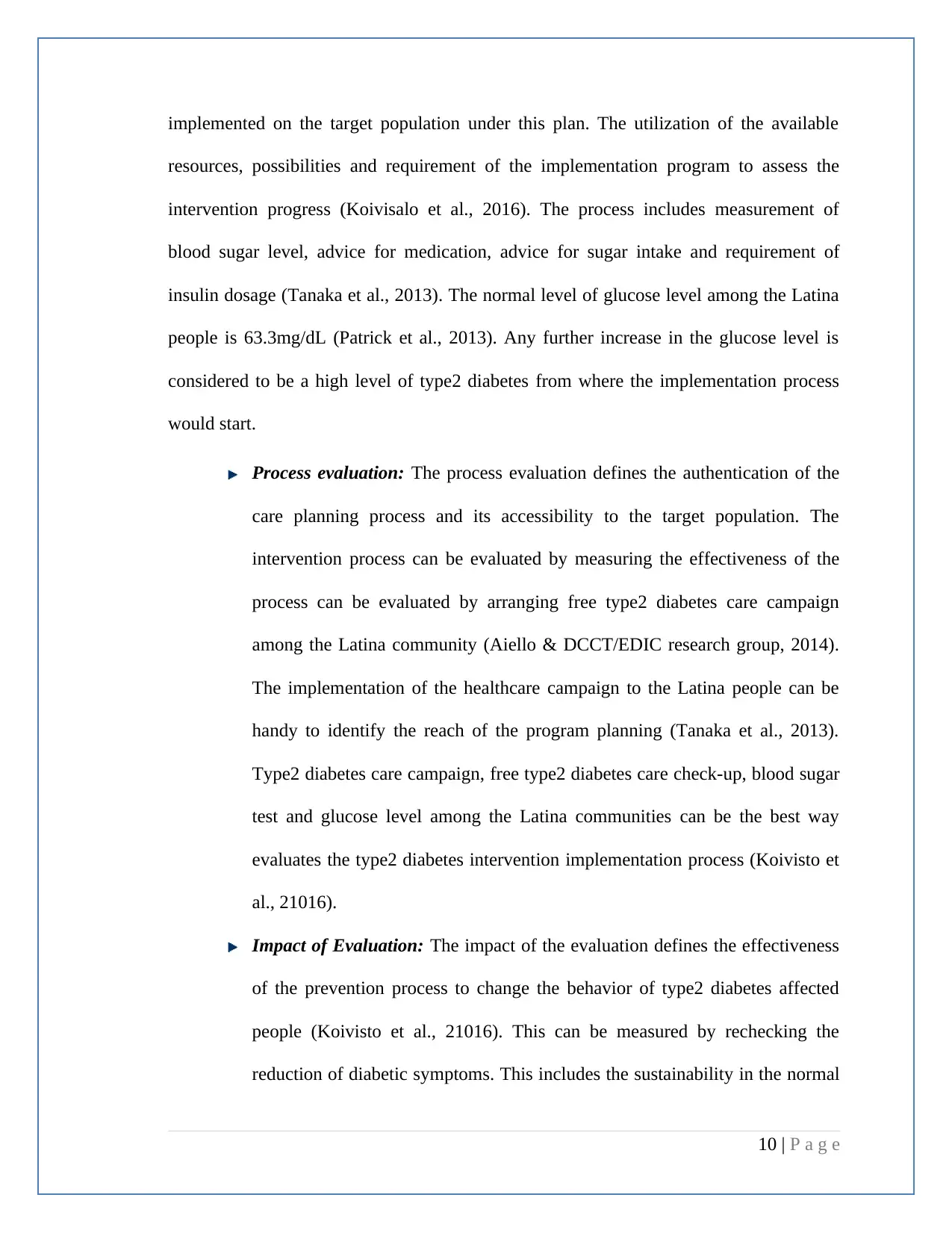
implemented on the target population under this plan. The utilization of the available
resources, possibilities and requirement of the implementation program to assess the
intervention progress (Koivisalo et al., 2016). The process includes measurement of
blood sugar level, advice for medication, advice for sugar intake and requirement of
insulin dosage (Tanaka et al., 2013). The normal level of glucose level among the Latina
people is 63.3mg/dL (Patrick et al., 2013). Any further increase in the glucose level is
considered to be a high level of type2 diabetes from where the implementation process
would start.
Process evaluation: The process evaluation defines the authentication of the
care planning process and its accessibility to the target population. The
intervention process can be evaluated by measuring the effectiveness of the
process can be evaluated by arranging free type2 diabetes care campaign
among the Latina community (Aiello & DCCT/EDIC research group, 2014).
The implementation of the healthcare campaign to the Latina people can be
handy to identify the reach of the program planning (Tanaka et al., 2013).
Type2 diabetes care campaign, free type2 diabetes care check-up, blood sugar
test and glucose level among the Latina communities can be the best way
evaluates the type2 diabetes intervention implementation process (Koivisto et
al., 21016).
Impact of Evaluation: The impact of the evaluation defines the effectiveness
of the prevention process to change the behavior of type2 diabetes affected
people (Koivisto et al., 21016). This can be measured by rechecking the
reduction of diabetic symptoms. This includes the sustainability in the normal
10 | P a g e
resources, possibilities and requirement of the implementation program to assess the
intervention progress (Koivisalo et al., 2016). The process includes measurement of
blood sugar level, advice for medication, advice for sugar intake and requirement of
insulin dosage (Tanaka et al., 2013). The normal level of glucose level among the Latina
people is 63.3mg/dL (Patrick et al., 2013). Any further increase in the glucose level is
considered to be a high level of type2 diabetes from where the implementation process
would start.
Process evaluation: The process evaluation defines the authentication of the
care planning process and its accessibility to the target population. The
intervention process can be evaluated by measuring the effectiveness of the
process can be evaluated by arranging free type2 diabetes care campaign
among the Latina community (Aiello & DCCT/EDIC research group, 2014).
The implementation of the healthcare campaign to the Latina people can be
handy to identify the reach of the program planning (Tanaka et al., 2013).
Type2 diabetes care campaign, free type2 diabetes care check-up, blood sugar
test and glucose level among the Latina communities can be the best way
evaluates the type2 diabetes intervention implementation process (Koivisto et
al., 21016).
Impact of Evaluation: The impact of the evaluation defines the effectiveness
of the prevention process to change the behavior of type2 diabetes affected
people (Koivisto et al., 21016). This can be measured by rechecking the
reduction of diabetic symptoms. This includes the sustainability in the normal
10 | P a g e
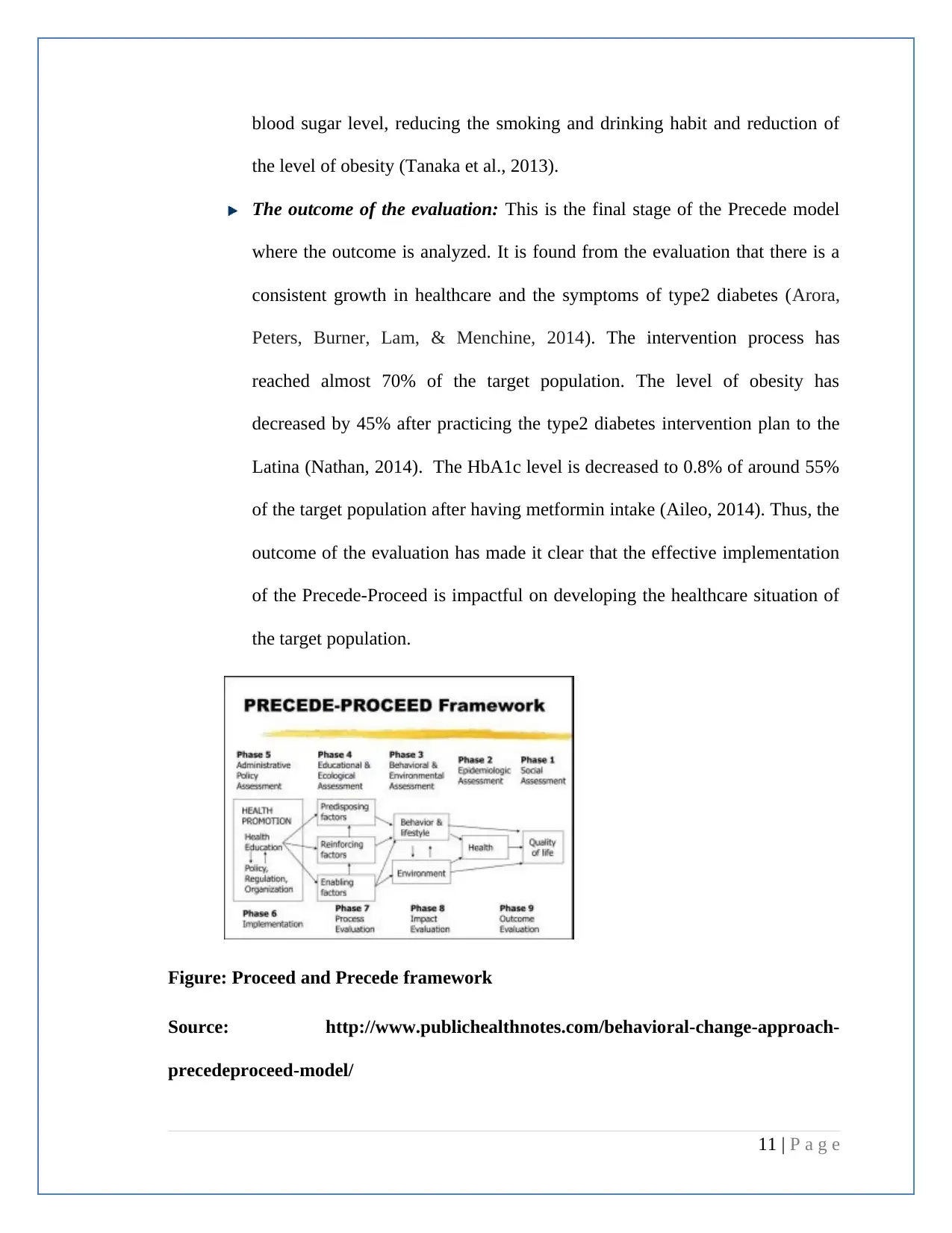
blood sugar level, reducing the smoking and drinking habit and reduction of
the level of obesity (Tanaka et al., 2013).
The outcome of the evaluation: This is the final stage of the Precede model
where the outcome is analyzed. It is found from the evaluation that there is a
consistent growth in healthcare and the symptoms of type2 diabetes (Arora,
Peters, Burner, Lam, & Menchine, 2014). The intervention process has
reached almost 70% of the target population. The level of obesity has
decreased by 45% after practicing the type2 diabetes intervention plan to the
Latina (Nathan, 2014). The HbA1c level is decreased to 0.8% of around 55%
of the target population after having metformin intake (Aileo, 2014). Thus, the
outcome of the evaluation has made it clear that the effective implementation
of the Precede-Proceed is impactful on developing the healthcare situation of
the target population.
Figure: Proceed and Precede framework
Source: http://www.publichealthnotes.com/behavioral-change-approach-
precedeproceed-model/
11 | P a g e
the level of obesity (Tanaka et al., 2013).
The outcome of the evaluation: This is the final stage of the Precede model
where the outcome is analyzed. It is found from the evaluation that there is a
consistent growth in healthcare and the symptoms of type2 diabetes (Arora,
Peters, Burner, Lam, & Menchine, 2014). The intervention process has
reached almost 70% of the target population. The level of obesity has
decreased by 45% after practicing the type2 diabetes intervention plan to the
Latina (Nathan, 2014). The HbA1c level is decreased to 0.8% of around 55%
of the target population after having metformin intake (Aileo, 2014). Thus, the
outcome of the evaluation has made it clear that the effective implementation
of the Precede-Proceed is impactful on developing the healthcare situation of
the target population.
Figure: Proceed and Precede framework
Source: http://www.publichealthnotes.com/behavioral-change-approach-
precedeproceed-model/
11 | P a g e
You're viewing a preview
Unlock full access by subscribing today!
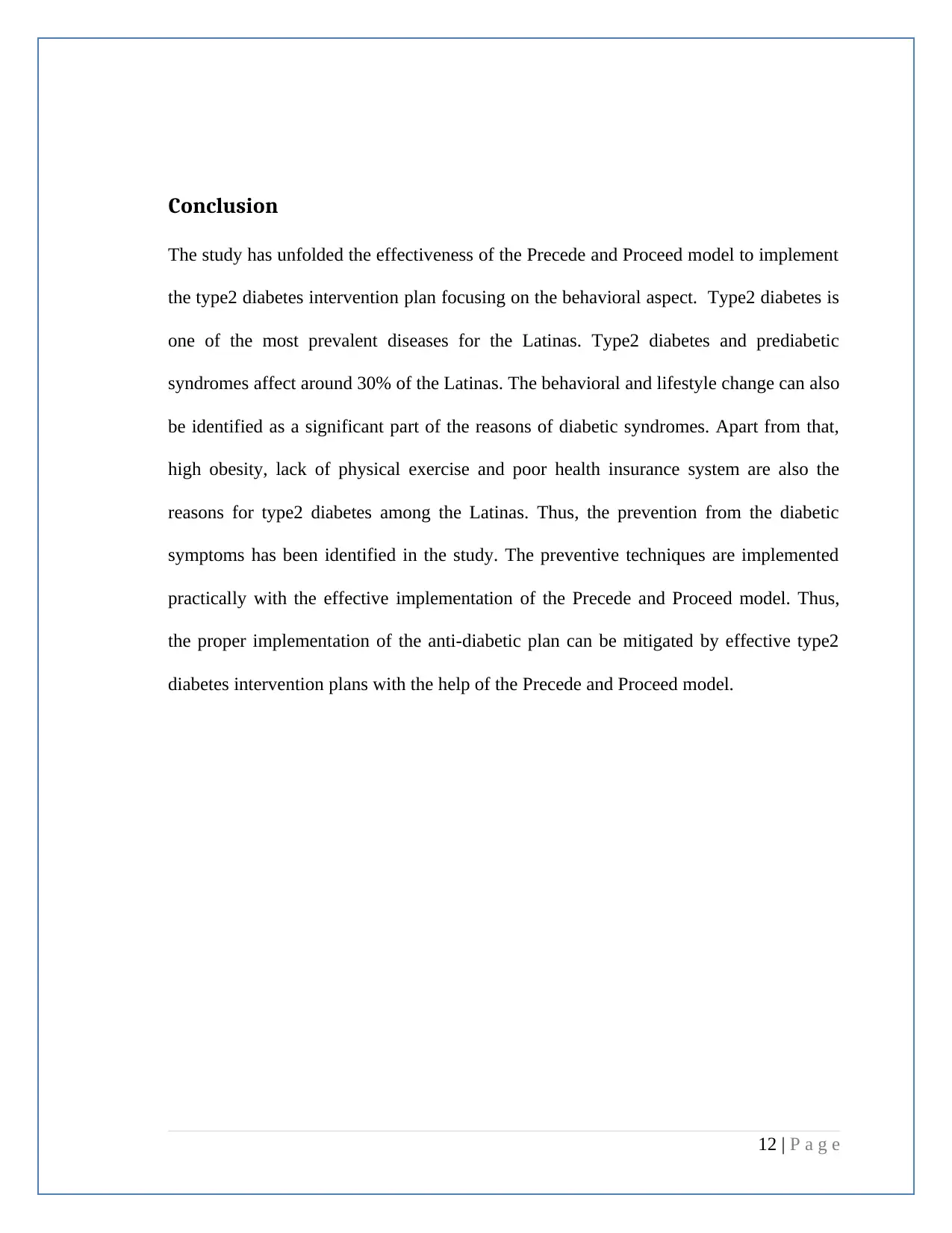
Conclusion
The study has unfolded the effectiveness of the Precede and Proceed model to implement
the type2 diabetes intervention plan focusing on the behavioral aspect. Type2 diabetes is
one of the most prevalent diseases for the Latinas. Type2 diabetes and prediabetic
syndromes affect around 30% of the Latinas. The behavioral and lifestyle change can also
be identified as a significant part of the reasons of diabetic syndromes. Apart from that,
high obesity, lack of physical exercise and poor health insurance system are also the
reasons for type2 diabetes among the Latinas. Thus, the prevention from the diabetic
symptoms has been identified in the study. The preventive techniques are implemented
practically with the effective implementation of the Precede and Proceed model. Thus,
the proper implementation of the anti-diabetic plan can be mitigated by effective type2
diabetes intervention plans with the help of the Precede and Proceed model.
12 | P a g e
The study has unfolded the effectiveness of the Precede and Proceed model to implement
the type2 diabetes intervention plan focusing on the behavioral aspect. Type2 diabetes is
one of the most prevalent diseases for the Latinas. Type2 diabetes and prediabetic
syndromes affect around 30% of the Latinas. The behavioral and lifestyle change can also
be identified as a significant part of the reasons of diabetic syndromes. Apart from that,
high obesity, lack of physical exercise and poor health insurance system are also the
reasons for type2 diabetes among the Latinas. Thus, the prevention from the diabetic
symptoms has been identified in the study. The preventive techniques are implemented
practically with the effective implementation of the Precede and Proceed model. Thus,
the proper implementation of the anti-diabetic plan can be mitigated by effective type2
diabetes intervention plans with the help of the Precede and Proceed model.
12 | P a g e
Paraphrase This Document
Need a fresh take? Get an instant paraphrase of this document with our AI Paraphraser
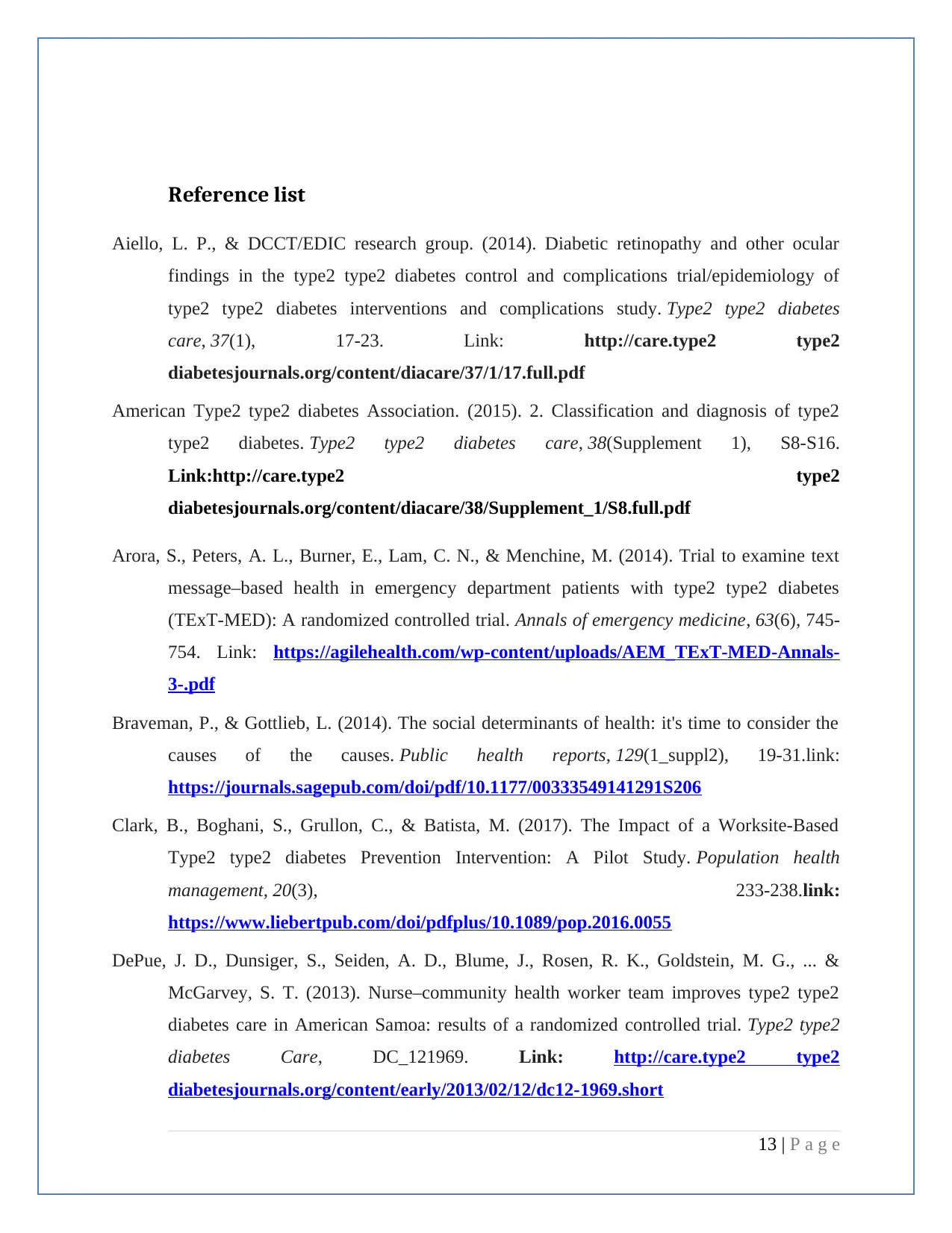
Reference list
Aiello, L. P., & DCCT/EDIC research group. (2014). Diabetic retinopathy and other ocular
findings in the type2 type2 diabetes control and complications trial/epidemiology of
type2 type2 diabetes interventions and complications study. Type2 type2 diabetes
care, 37(1), 17-23. Link: http://care.type2 type2
diabetesjournals.org/content/diacare/37/1/17.full.pdf
American Type2 type2 diabetes Association. (2015). 2. Classification and diagnosis of type2
type2 diabetes. Type2 type2 diabetes care, 38(Supplement 1), S8-S16.
Link:http://care.type2 type2
diabetesjournals.org/content/diacare/38/Supplement_1/S8.full.pdf
Arora, S., Peters, A. L., Burner, E., Lam, C. N., & Menchine, M. (2014). Trial to examine text
message–based health in emergency department patients with type2 type2 diabetes
(TExT-MED): A randomized controlled trial. Annals of emergency medicine, 63(6), 745-
754. Link: https://agilehealth.com/wp-content/uploads/AEM_TExT-MED-Annals-
3-.pdf
Braveman, P., & Gottlieb, L. (2014). The social determinants of health: it's time to consider the
causes of the causes. Public health reports, 129(1_suppl2), 19-31.link:
https://journals.sagepub.com/doi/pdf/10.1177/00333549141291S206
Clark, B., Boghani, S., Grullon, C., & Batista, M. (2017). The Impact of a Worksite-Based
Type2 type2 diabetes Prevention Intervention: A Pilot Study. Population health
management, 20(3), 233-238.link:
https://www.liebertpub.com/doi/pdfplus/10.1089/pop.2016.0055
DePue, J. D., Dunsiger, S., Seiden, A. D., Blume, J., Rosen, R. K., Goldstein, M. G., ... &
McGarvey, S. T. (2013). Nurse–community health worker team improves type2 type2
diabetes care in American Samoa: results of a randomized controlled trial. Type2 type2
diabetes Care, DC_121969. Link: http://care.type2 type2
diabetesjournals.org/content/early/2013/02/12/dc12-1969.short
13 | P a g e
Aiello, L. P., & DCCT/EDIC research group. (2014). Diabetic retinopathy and other ocular
findings in the type2 type2 diabetes control and complications trial/epidemiology of
type2 type2 diabetes interventions and complications study. Type2 type2 diabetes
care, 37(1), 17-23. Link: http://care.type2 type2
diabetesjournals.org/content/diacare/37/1/17.full.pdf
American Type2 type2 diabetes Association. (2015). 2. Classification and diagnosis of type2
type2 diabetes. Type2 type2 diabetes care, 38(Supplement 1), S8-S16.
Link:http://care.type2 type2
diabetesjournals.org/content/diacare/38/Supplement_1/S8.full.pdf
Arora, S., Peters, A. L., Burner, E., Lam, C. N., & Menchine, M. (2014). Trial to examine text
message–based health in emergency department patients with type2 type2 diabetes
(TExT-MED): A randomized controlled trial. Annals of emergency medicine, 63(6), 745-
754. Link: https://agilehealth.com/wp-content/uploads/AEM_TExT-MED-Annals-
3-.pdf
Braveman, P., & Gottlieb, L. (2014). The social determinants of health: it's time to consider the
causes of the causes. Public health reports, 129(1_suppl2), 19-31.link:
https://journals.sagepub.com/doi/pdf/10.1177/00333549141291S206
Clark, B., Boghani, S., Grullon, C., & Batista, M. (2017). The Impact of a Worksite-Based
Type2 type2 diabetes Prevention Intervention: A Pilot Study. Population health
management, 20(3), 233-238.link:
https://www.liebertpub.com/doi/pdfplus/10.1089/pop.2016.0055
DePue, J. D., Dunsiger, S., Seiden, A. D., Blume, J., Rosen, R. K., Goldstein, M. G., ... &
McGarvey, S. T. (2013). Nurse–community health worker team improves type2 type2
diabetes care in American Samoa: results of a randomized controlled trial. Type2 type2
diabetes Care, DC_121969. Link: http://care.type2 type2
diabetesjournals.org/content/early/2013/02/12/dc12-1969.short
13 | P a g e
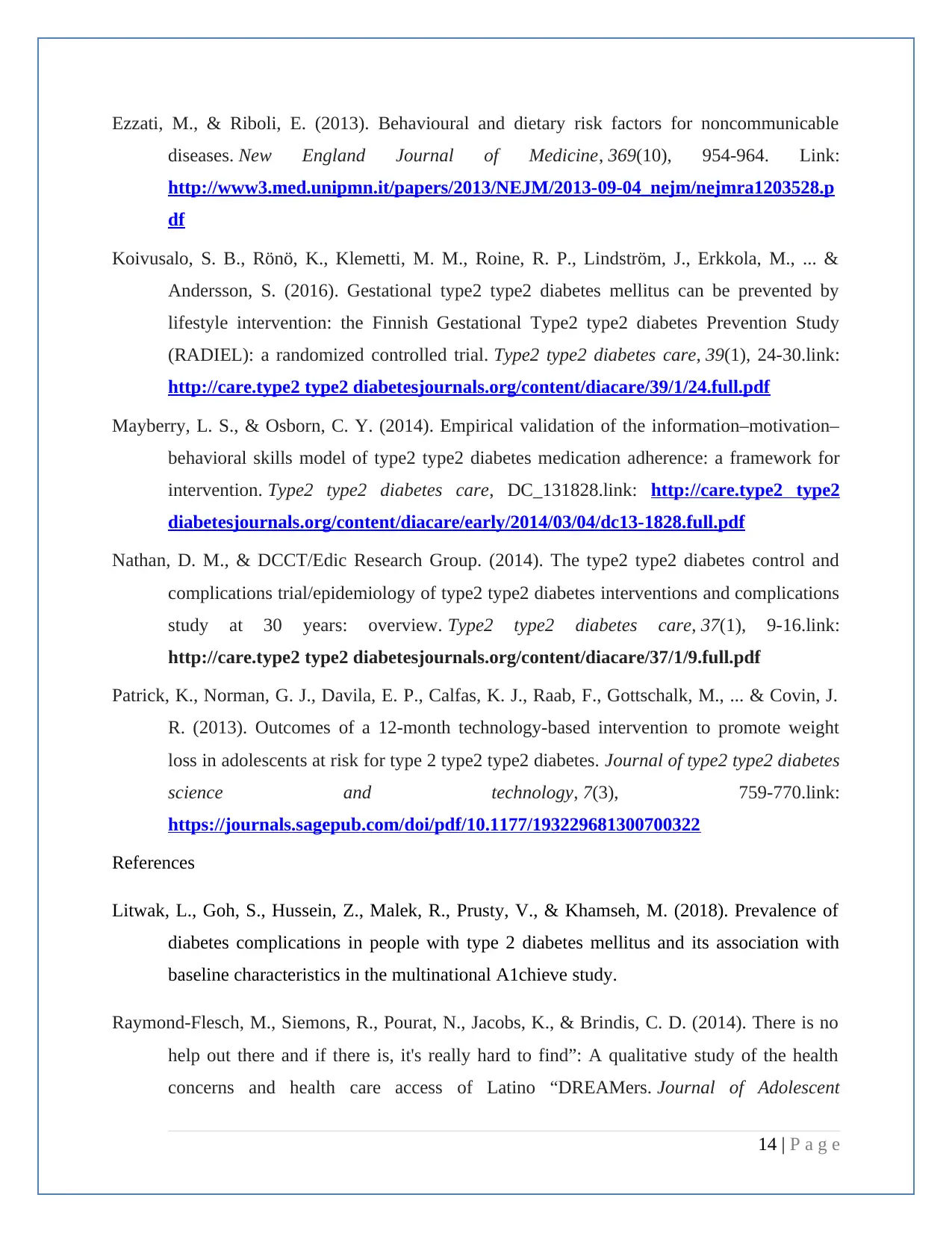
Ezzati, M., & Riboli, E. (2013). Behavioural and dietary risk factors for noncommunicable
diseases. New England Journal of Medicine, 369(10), 954-964. Link:
http://www3.med.unipmn.it/papers/2013/NEJM/2013-09-04_nejm/nejmra1203528.p
df
Koivusalo, S. B., Rönö, K., Klemetti, M. M., Roine, R. P., Lindström, J., Erkkola, M., ... &
Andersson, S. (2016). Gestational type2 type2 diabetes mellitus can be prevented by
lifestyle intervention: the Finnish Gestational Type2 type2 diabetes Prevention Study
(RADIEL): a randomized controlled trial. Type2 type2 diabetes care, 39(1), 24-30.link:
http://care.type2 type2 diabetesjournals.org/content/diacare/39/1/24.full.pdf
Mayberry, L. S., & Osborn, C. Y. (2014). Empirical validation of the information–motivation–
behavioral skills model of type2 type2 diabetes medication adherence: a framework for
intervention. Type2 type2 diabetes care, DC_131828.link: http://care.type2 type2
diabetesjournals.org/content/diacare/early/2014/03/04/dc13-1828.full.pdf
Nathan, D. M., & DCCT/Edic Research Group. (2014). The type2 type2 diabetes control and
complications trial/epidemiology of type2 type2 diabetes interventions and complications
study at 30 years: overview. Type2 type2 diabetes care, 37(1), 9-16.link:
http://care.type2 type2 diabetesjournals.org/content/diacare/37/1/9.full.pdf
Patrick, K., Norman, G. J., Davila, E. P., Calfas, K. J., Raab, F., Gottschalk, M., ... & Covin, J.
R. (2013). Outcomes of a 12-month technology-based intervention to promote weight
loss in adolescents at risk for type 2 type2 type2 diabetes. Journal of type2 type2 diabetes
science and technology, 7(3), 759-770.link:
https://journals.sagepub.com/doi/pdf/10.1177/193229681300700322
References
Litwak, L., Goh, S., Hussein, Z., Malek, R., Prusty, V., & Khamseh, M. (2018). Prevalence of
diabetes complications in people with type 2 diabetes mellitus and its association with
baseline characteristics in the multinational A1chieve study.
Raymond-Flesch, M., Siemons, R., Pourat, N., Jacobs, K., & Brindis, C. D. (2014). There is no
help out there and if there is, it's really hard to find”: A qualitative study of the health
concerns and health care access of Latino “DREAMers. Journal of Adolescent
14 | P a g e
diseases. New England Journal of Medicine, 369(10), 954-964. Link:
http://www3.med.unipmn.it/papers/2013/NEJM/2013-09-04_nejm/nejmra1203528.p
df
Koivusalo, S. B., Rönö, K., Klemetti, M. M., Roine, R. P., Lindström, J., Erkkola, M., ... &
Andersson, S. (2016). Gestational type2 type2 diabetes mellitus can be prevented by
lifestyle intervention: the Finnish Gestational Type2 type2 diabetes Prevention Study
(RADIEL): a randomized controlled trial. Type2 type2 diabetes care, 39(1), 24-30.link:
http://care.type2 type2 diabetesjournals.org/content/diacare/39/1/24.full.pdf
Mayberry, L. S., & Osborn, C. Y. (2014). Empirical validation of the information–motivation–
behavioral skills model of type2 type2 diabetes medication adherence: a framework for
intervention. Type2 type2 diabetes care, DC_131828.link: http://care.type2 type2
diabetesjournals.org/content/diacare/early/2014/03/04/dc13-1828.full.pdf
Nathan, D. M., & DCCT/Edic Research Group. (2014). The type2 type2 diabetes control and
complications trial/epidemiology of type2 type2 diabetes interventions and complications
study at 30 years: overview. Type2 type2 diabetes care, 37(1), 9-16.link:
http://care.type2 type2 diabetesjournals.org/content/diacare/37/1/9.full.pdf
Patrick, K., Norman, G. J., Davila, E. P., Calfas, K. J., Raab, F., Gottschalk, M., ... & Covin, J.
R. (2013). Outcomes of a 12-month technology-based intervention to promote weight
loss in adolescents at risk for type 2 type2 type2 diabetes. Journal of type2 type2 diabetes
science and technology, 7(3), 759-770.link:
https://journals.sagepub.com/doi/pdf/10.1177/193229681300700322
References
Litwak, L., Goh, S., Hussein, Z., Malek, R., Prusty, V., & Khamseh, M. (2018). Prevalence of
diabetes complications in people with type 2 diabetes mellitus and its association with
baseline characteristics in the multinational A1chieve study.
Raymond-Flesch, M., Siemons, R., Pourat, N., Jacobs, K., & Brindis, C. D. (2014). There is no
help out there and if there is, it's really hard to find”: A qualitative study of the health
concerns and health care access of Latino “DREAMers. Journal of Adolescent
14 | P a g e
You're viewing a preview
Unlock full access by subscribing today!
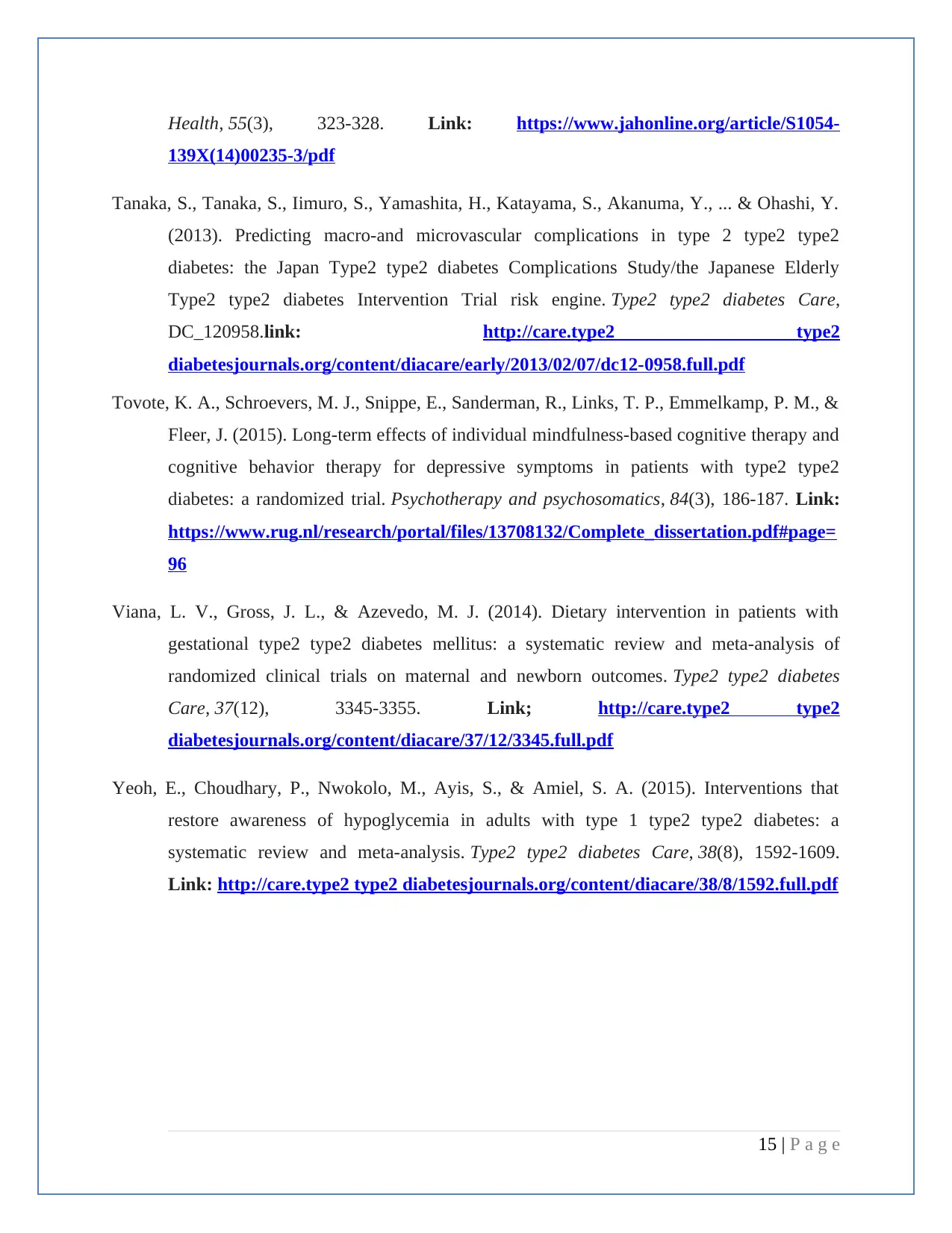
Health, 55(3), 323-328. Link: https://www.jahonline.org/article/S1054-
139X(14)00235-3/pdf
Tanaka, S., Tanaka, S., Iimuro, S., Yamashita, H., Katayama, S., Akanuma, Y., ... & Ohashi, Y.
(2013). Predicting macro-and microvascular complications in type 2 type2 type2
diabetes: the Japan Type2 type2 diabetes Complications Study/the Japanese Elderly
Type2 type2 diabetes Intervention Trial risk engine. Type2 type2 diabetes Care,
DC_120958.link: http://care.type2 type2
diabetesjournals.org/content/diacare/early/2013/02/07/dc12-0958.full.pdf
Tovote, K. A., Schroevers, M. J., Snippe, E., Sanderman, R., Links, T. P., Emmelkamp, P. M., &
Fleer, J. (2015). Long-term effects of individual mindfulness-based cognitive therapy and
cognitive behavior therapy for depressive symptoms in patients with type2 type2
diabetes: a randomized trial. Psychotherapy and psychosomatics, 84(3), 186-187. Link:
https://www.rug.nl/research/portal/files/13708132/Complete_dissertation.pdf#page=
96
Viana, L. V., Gross, J. L., & Azevedo, M. J. (2014). Dietary intervention in patients with
gestational type2 type2 diabetes mellitus: a systematic review and meta-analysis of
randomized clinical trials on maternal and newborn outcomes. Type2 type2 diabetes
Care, 37(12), 3345-3355. Link; http://care.type2 type2
diabetesjournals.org/content/diacare/37/12/3345.full.pdf
Yeoh, E., Choudhary, P., Nwokolo, M., Ayis, S., & Amiel, S. A. (2015). Interventions that
restore awareness of hypoglycemia in adults with type 1 type2 type2 diabetes: a
systematic review and meta-analysis. Type2 type2 diabetes Care, 38(8), 1592-1609.
Link: http://care.type2 type2 diabetesjournals.org/content/diacare/38/8/1592.full.pdf
15 | P a g e
139X(14)00235-3/pdf
Tanaka, S., Tanaka, S., Iimuro, S., Yamashita, H., Katayama, S., Akanuma, Y., ... & Ohashi, Y.
(2013). Predicting macro-and microvascular complications in type 2 type2 type2
diabetes: the Japan Type2 type2 diabetes Complications Study/the Japanese Elderly
Type2 type2 diabetes Intervention Trial risk engine. Type2 type2 diabetes Care,
DC_120958.link: http://care.type2 type2
diabetesjournals.org/content/diacare/early/2013/02/07/dc12-0958.full.pdf
Tovote, K. A., Schroevers, M. J., Snippe, E., Sanderman, R., Links, T. P., Emmelkamp, P. M., &
Fleer, J. (2015). Long-term effects of individual mindfulness-based cognitive therapy and
cognitive behavior therapy for depressive symptoms in patients with type2 type2
diabetes: a randomized trial. Psychotherapy and psychosomatics, 84(3), 186-187. Link:
https://www.rug.nl/research/portal/files/13708132/Complete_dissertation.pdf#page=
96
Viana, L. V., Gross, J. L., & Azevedo, M. J. (2014). Dietary intervention in patients with
gestational type2 type2 diabetes mellitus: a systematic review and meta-analysis of
randomized clinical trials on maternal and newborn outcomes. Type2 type2 diabetes
Care, 37(12), 3345-3355. Link; http://care.type2 type2
diabetesjournals.org/content/diacare/37/12/3345.full.pdf
Yeoh, E., Choudhary, P., Nwokolo, M., Ayis, S., & Amiel, S. A. (2015). Interventions that
restore awareness of hypoglycemia in adults with type 1 type2 type2 diabetes: a
systematic review and meta-analysis. Type2 type2 diabetes Care, 38(8), 1592-1609.
Link: http://care.type2 type2 diabetesjournals.org/content/diacare/38/8/1592.full.pdf
15 | P a g e
1 out of 16
Related Documents
Your All-in-One AI-Powered Toolkit for Academic Success.
+13062052269
info@desklib.com
Available 24*7 on WhatsApp / Email
![[object Object]](/_next/static/media/star-bottom.7253800d.svg)
Unlock your academic potential
© 2024 | Zucol Services PVT LTD | All rights reserved.




